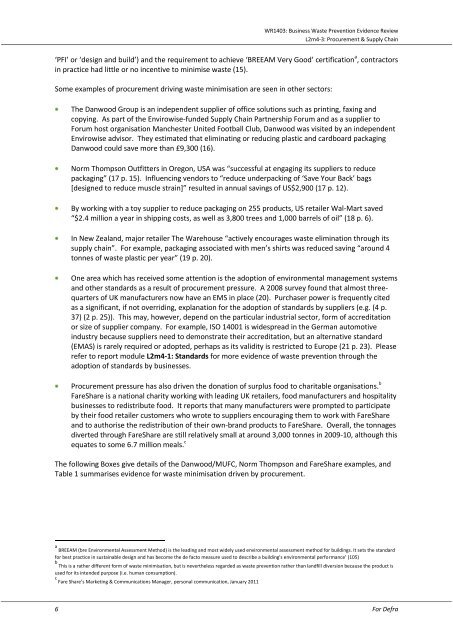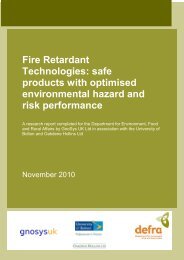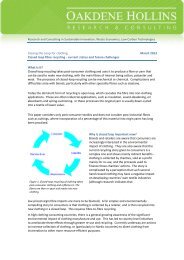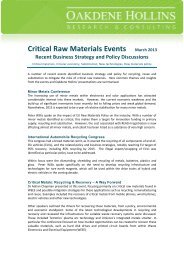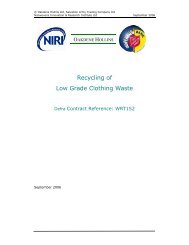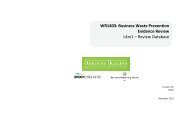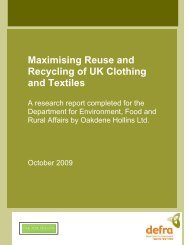Procurement and Supply Chain - Oakdene Hollins
Procurement and Supply Chain - Oakdene Hollins
Procurement and Supply Chain - Oakdene Hollins
You also want an ePaper? Increase the reach of your titles
YUMPU automatically turns print PDFs into web optimized ePapers that Google loves.
WR1403: Business Waste Prevention Evidence Review<br />
L2m4-3: <strong>Procurement</strong> & <strong>Supply</strong> <strong>Chain</strong><br />
‘PFI’ or ‘design <strong>and</strong> build’) <strong>and</strong> the requirement to achieve ‘BREEAM Very Good’ certification a , contractors<br />
in practice had little or no incentive to minimise waste (15).<br />
Some examples of procurement driving waste minimisation are seen in other sectors:<br />
The Danwood Group is an independent supplier of office solutions such as printing, faxing <strong>and</strong><br />
copying. As part of the Envirowise-funded <strong>Supply</strong> <strong>Chain</strong> Partnership Forum <strong>and</strong> as a supplier to<br />
Forum host organisation Manchester United Football Club, Danwood was visited by an independent<br />
Envirowise advisor. They estimated that eliminating or reducing plastic <strong>and</strong> cardboard packaging<br />
Danwood could save more than £9,300 (16).<br />
Norm Thompson Outfitters in Oregon, USA was “successful at engaging its suppliers to reduce<br />
packaging” (17 p. 15). Influencing vendors to “reduce underpacking of ‘Save Your Back’ bags<br />
[designed to reduce muscle strain]” resulted in annual savings of US$2,900 (17 p. 12).<br />
By working with a toy supplier to reduce packaging on 255 products, US retailer Wal-Mart saved<br />
“$2.4 million a year in shipping costs, as well as 3,800 trees <strong>and</strong> 1,000 barrels of oil” (18 p. 6).<br />
In New Zeal<strong>and</strong>, major retailer The Warehouse “actively encourages waste elimination through its<br />
supply chain”. For example, packaging associated with men’s shirts was reduced saving “around 4<br />
tonnes of waste plastic per year” (19 p. 20).<br />
One area which has received some attention is the adoption of environmental management systems<br />
<strong>and</strong> other st<strong>and</strong>ards as a result of procurement pressure. A 2008 survey found that almost threequarters<br />
of UK manufacturers now have an EMS in place (20). Purchaser power is frequently cited<br />
as a significant, if not overriding, explanation for the adoption of st<strong>and</strong>ards by suppliers (e.g. (4 p.<br />
37) (2 p. 25)). This may, however, depend on the particular industrial sector, form of accreditation<br />
or size of supplier company. For example, ISO 14001 is widespread in the German automotive<br />
industry because suppliers need to demonstrate their accreditation, but an alternative st<strong>and</strong>ard<br />
(EMAS) is rarely required or adopted, perhaps as its validity is restricted to Europe (21 p. 23). Please<br />
refer to report module L2m4-1: St<strong>and</strong>ards for more evidence of waste prevention through the<br />
adoption of st<strong>and</strong>ards by businesses.<br />
<strong>Procurement</strong> pressure has also driven the donation of surplus food to charitable organisations. b<br />
FareShare is a national charity working with leading UK retailers, food manufacturers <strong>and</strong> hospitality<br />
businesses to redistribute food. It reports that many manufacturers were prompted to participate<br />
by their food retailer customers who wrote to suppliers encouraging them to work with FareShare<br />
<strong>and</strong> to authorise the redistribution of their own-br<strong>and</strong> products to FareShare. Overall, the tonnages<br />
diverted through FareShare are still relatively small at around 3,000 tonnes in 2009-10, although this<br />
equates to some 6.7 million meals. c<br />
The following Boxes give details of the Danwood/MUFC, Norm Thompson <strong>and</strong> FareShare examples, <strong>and</strong><br />
Table 1 summarises evidence for waste minimisation driven by procurement.<br />
a BREEAM (bre Environmental Assessment Method) is the leading <strong>and</strong> most widely used environmental assessment method for buildings. It sets the st<strong>and</strong>ard<br />
for best practice in sustainable design <strong>and</strong> has become the de facto measure used to describe a building's environmental performance’ (105)<br />
b This is a rather different form of waste minimisation, but is nevertheless regarded as waste prevention rather than l<strong>and</strong>fill diversion because the product is<br />
used for its intended purpose (i.e. human consumption).<br />
c Fare Share’s Marketing & Communications Manager, personal communication, January 2011<br />
6 For Defra


